What is LASIK?
LASIK (Laser in-situ Keratomileusis) is a form of laser refractive surgery to correct your vision. During LASIK surgery, a corneal flap is created with a Femtosecond laser. The corneal flap is lifted and an Excimer laser with eye-tracking function is used to reshape the cornea to correct the refractive error with an all-laser, bladeless technique. The corneal flap is then replaced.
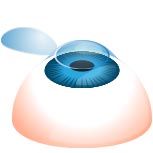
Corneal Flap Creation
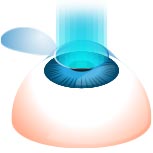
Laser Sculpting
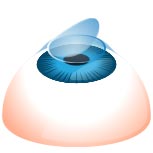
Flap Re-positioned
Who is suitable for LASIK surgery?
You have to be aged 21 and above to undergo LASIK surgery. You should not be pregnant or have cataracts, glaucoma, or any retinal diseases. Some conditions such as systemic lupus erythematosus (SLE) and rheumatoid arthritis, or certain medications may also preclude you from LASIK surgery. Your ophthalmologist will perform a thorough examination of your eyes. Further tests are required to confirm your degree as well as the shape and thickness of your cornea to assess your suitability for LASIK surgery.
How can I get LASIK done?
You can make an appointment to see an ophthalmologist at the Raffles LASIK Centre. Your ophthalmologist will assess if you are suitable for LASIK. There are generally three appointments before your LASIK journey is completed. They are as follows:


Pre-LASIK Surgery Assessment
Your ophthalmologist will assess if you are suitable for LASIK. You can also discuss any concerns you might have and schedule a surgery date with your doctor.
DO• Inform your doctor of any medical and eye condition you might have. |
|
DO NOT• Wear contact lenses on the day of the assessment and surgery. |
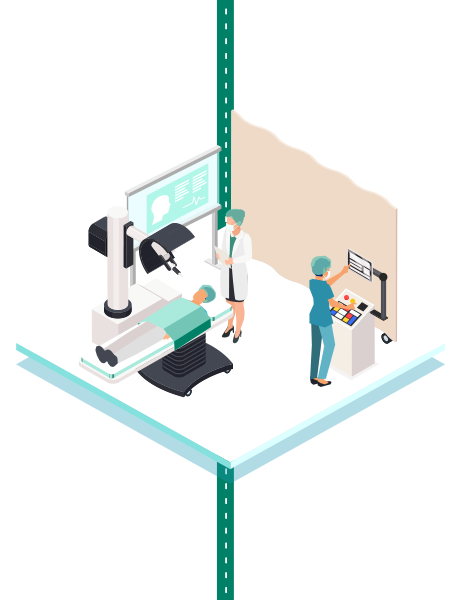
LASIK Surgery
Your ophthalmologist will examine your eyes before your surgery. A LASIK procedure usually takes about half an hour. You will be reviewed by your doctor after the procedure before you go home. The whole process will take about two hours.
DO• Wear comfortable clothing. |
|
DO NOT• Wear make-up (especially eye make-up), hair spray or perfume. • Consume heavy meals or drink alcohol before the surgery. |

Post-LASIK Surgery (Follow-up Meeting)
During the follow-up meeting, your ophthalmologist will check your vision.
DO• Use the eye-drops that your doctor has given you as prescribed. • Wear an eye shield during sleep. • Expect some hazy vision and eye irritation for a few hours. |
|
DO NOT• Rub your eyes. • Apply eye make-up for at least one week. • Engage in vigorous exercises such as swimming for 1 month. • Participate in any extreme sports (diving or mountain climbing) or other contact sports |
Meet Our Ophthalmologist
Frequently Asked Questions
LASIK surgery can be used to treat myopia between 100 to 1,500 degrees and astigmatism of up to 600 degrees. LASIK surgery can also be used to treat people with hyperopia of up to 500 degrees. However, this will depend on the thickness of your cornea.
Yes. After your eyes heal, the vision correction will be permanent.
Some patients experience glare, halos, dry eyes, and at times, a mild fluctuation of vision. This can occur during the first few days or even weeks after a LASIK surgery. However, most of these side effects will subside and resolve with time. Severe side effects such as corneal flap complications and corneal infections are very rare. If you experience any eye redness, pain, or vision loss after LASIK surgery, please inform your doctor immediately.
Yes, you can have LASIK surgery on both eyes on the same day.
Your ophthalmologist will numb your eye with eye drops before LASIK surgery. You might feel light pressure on your eye, but this will not cause you any pain. The feeling of having a foreign object in the operated eye will go away after a short while.
Your vision will be hazy for a few hours after LASIK surgery, but you will still be able to see well enough to move about. However, you should avoid taking public transport home on the day of surgery. You can expect normal vision the day after LASIK surgery.
While some people may experience slight under-correction or over-correction from LASIK surgery, less than one per cent of cases may have under- or over-correction that is significant enough to affect their vision. Enhancement LASIK surgery can be done to correct it.
Enhancement LASIK surgery should only be considered when your eyesight is under- or over-corrected by 100 degrees or more, or if the unaided vision is worse than 6/12. It should be performed at least three months after your LASIK surgery. Your ophthalmologist will evaluate the condition of your eye and assess the risks before deciding whether you are suitable for enhancement LASIK surgery.
After LASIK surgery, your distance vision should generally remain stable. However, there may be slight return of your degree years after LASIK. This is known as regression. When this happens, you may need a pair of glasses when driving at night or when watching a movie. You may also experience presbyopia (the gradual loss of our eyes' ability to focus on nearby objects) after the age of 40, as LASIK cannot prevent or effectively correct presbyopia. This is a normal phenomenon that comes with ageing and you may need reading glasses then.
LASIK surgery should not be done during pregnancy or when breastfeeding as the hormonal changes experienced during this time may affect the accuracy of the LASIK treatment. This also applies to those who are on hormonal therapy. You should wait at least three months after delivery and breastfeeding before undergoing LASIK surgery.

LASIK Technology
Raffles LASIK Centre uses the following machines:
Schwind Amaris® 1050RS Excimer Laser
The Schwind Amaris® 1050RS is one of the world’s fastest eye laser systems for refractive and therapeutic corneal surgery.
It has a repetition rate of 1,050Hz, 7D eye tracking and 0.54mm laser spot, allowing surgeons to conduct a LASIK surgery with speed, precision, and safety.

iFS® Advanced Femtosecond Laser
The IntraLase ® iFS femtosecond laser uses rapid pulses of laser light to create thin, uniform LASIK flaps with greater surgical precision.
The extremely fast laser speed and ablation of 1.3 seconds per dioptre (100 degrees) provides better patient safety and comfort. The Schwind Amaris® 1050RS can treat patients with a myopia of 1,000 degrees in 13 seconds.
With a fast repetition rate, the risk of corneal dehydration is minimised. This also reduces the time that the patient has to focus on green light during LASIK surgery. This improves the accuracy of the treatment.
Even when you focus your eyes on green light during LASIK surgery, your eyes may still make slight involuntary movements. Therefore, it is important to ensure exact centring and constant positioning of the eye for a precise and safe procedure.
Schwind Amaris®’s active 7D eye tracker provides a high level of precision as it is linked to diagnostic systems that capture all eye motions during a LASIK surgery. The 7D eye tracker adjusts accordingly as changes in pupil size are detected. All eye movements are recorded and actively compensated at 1,050 times per second.
This automatic function ensures that the laser is centralised throughout the LASIK surgery.
In LASIK surgery, a corneal flap is created by the femtosecond laser and lifted to expose the underlying corneal tissue. The excimer laser will then be used to change the shape of the cornea to correct refractive errors. Finally, the flap is then placed back in its original position and is expected to heal on its own.
In PRK surgery, the corneal epithelium (outermost layer of the cornea) is removed with laser and alcohol, and the excimer laser is used just like in LASIK surgery. A contact lens is placed on the eye after the treatment and the corneal epithelium is expected to regrow in about three to five days. There is no corneal flap creation like in LASIK surgery.
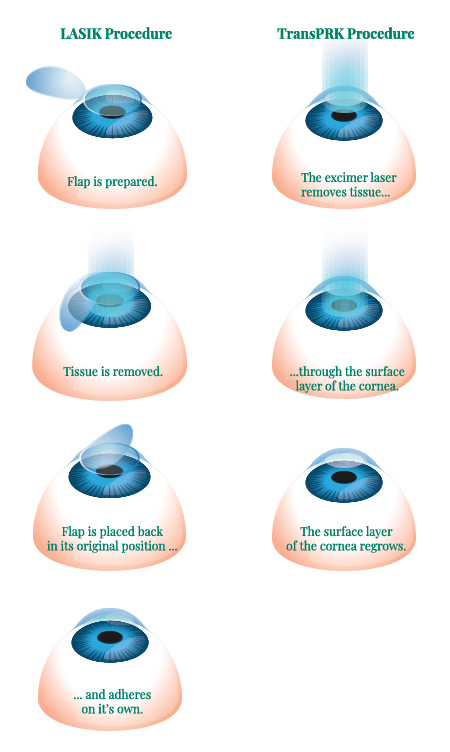
How does Photorefractive Keratectomy (PRK) differ from LASIK surgery?
Schwind Amaris®’s SmartSurfACE eye laser technology combines Schwind Amaris®’s Transepithelial PhotoRefractive Keratectomy (TransPRK) surface ablation method with SmartPulse Technology.
During a LASIK surgery, the eye laser corrects vision through the top layer of the cornea through a bladeless procedure without any incision. This leaves the cornea surface smoother after the procedure with an improved vision.
The use of iFS IntraLase® femtosecond laser will create microscopic bubbles at a specific position in the cornea. This helps to create a cornea flap, allowing for the corneal flap to be lifted with minimal manipulation. The flap creation is fast, and is usually completed in about 15 to 18 seconds.
Make An Appointment
Make an appointment to consult an ophthalmologist at our eye clinic. Select "Specialist Appointment". Under Specialist Appointment Details, select "Ophthalmology", and include any message you might have in the Remarks.
Make an enquiry. We will get back to you within 2 working days. You can reach us at 6311 1220.
